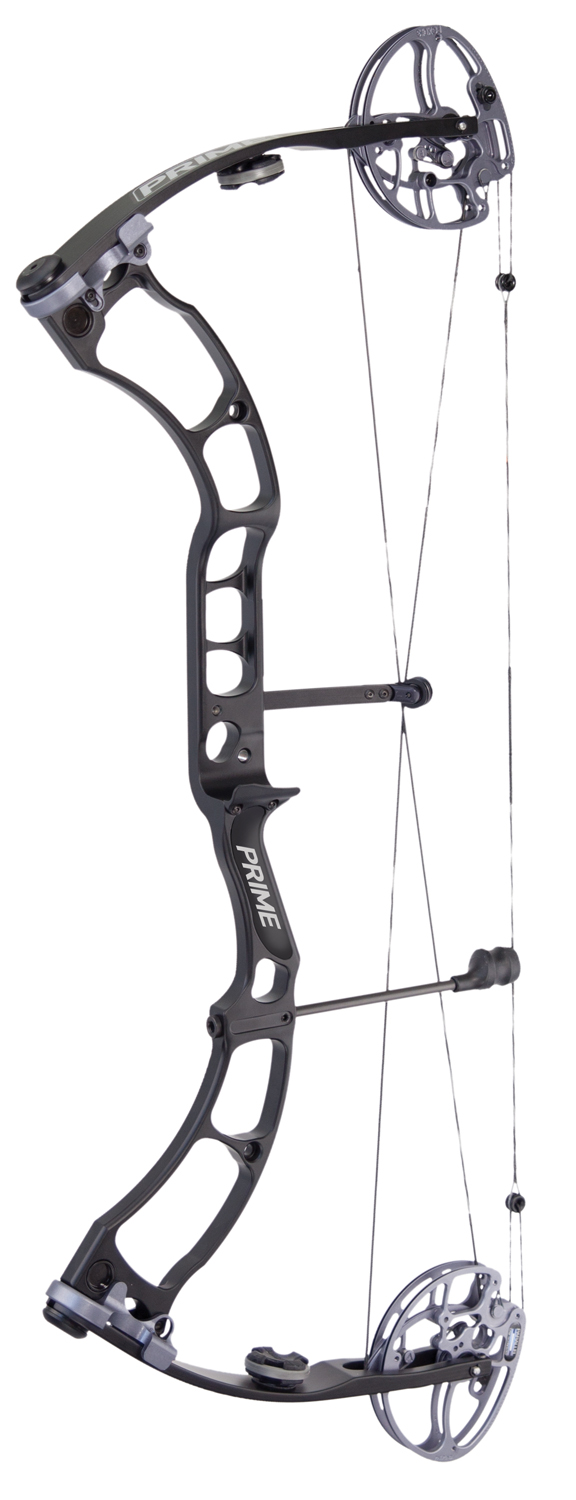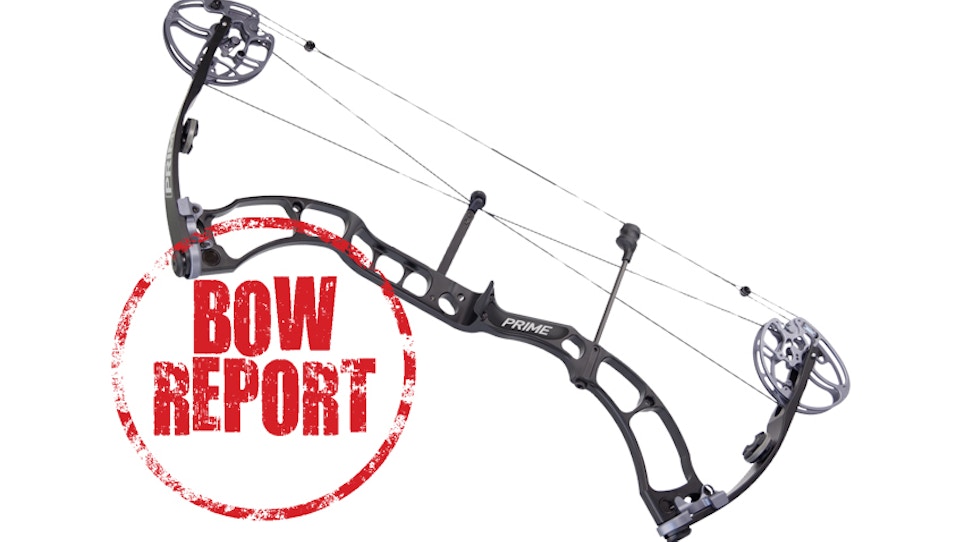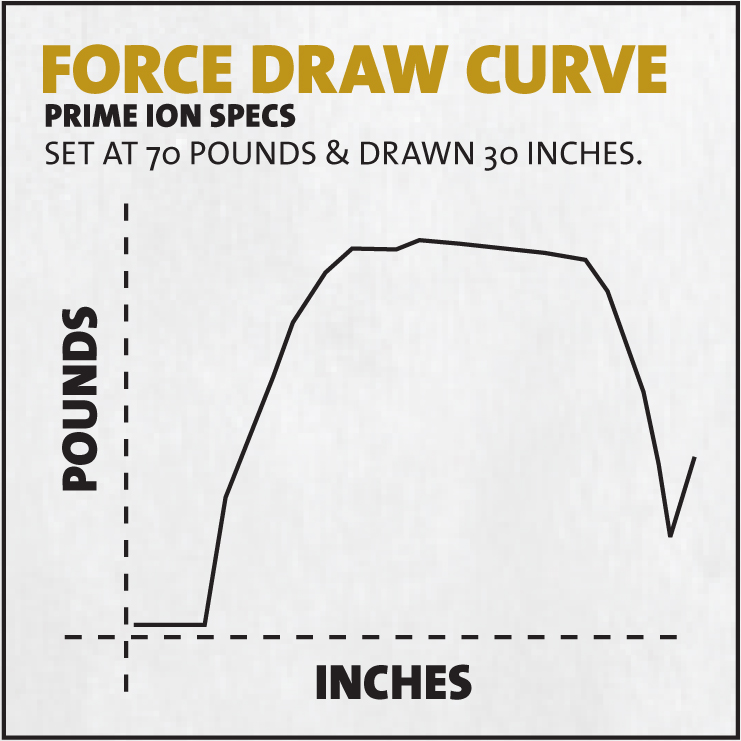One of two G5 bow companies (the other being Quest), Prime produces bows easily recognizable by their use of Prime’s Parallel Cam System. For those not already familiar with it, picture a pair of identical cams on each axle, sandwiched about ¼- to ½-inch apart. Strings from each cam are yoked to a single string a few inches from the cams. As noted in last year’s report on the Prime Rival, it doesn’t take a degree in engineering to see the advantages of this design: cam lean (a significant source of inconsistency and hence inaccuracy) is for all practical purposes eliminated, the string runs vertically down the centerline of the bow’s vertical axis to reduce torque and make tuning easier, and horizontal nock travel is improved. The Ion’s parallel cams are Prime’s latest PCXL cams, differing from predecessors primarily in their ability to achieve 85 percent letoff. Letoff is adjusted by moving the limb stop in or out, though this does affect draw length by as much as a half-inch.
 A bow is essentially a shooting platform, and Prime is all about providing a super stable shooting platform. In addition to the parallel-cam system, Prime’s risers are 7000 series aluminum and have been redesigned for 2015. Prime is calling the new 7000 series its strongest to date. Prime also boasts that its risers are the straightest in the industry. In addition, Prime bows feature Flexis-AR roller guards. These are adjustable to provide optimal fletching clearance.
A bow is essentially a shooting platform, and Prime is all about providing a super stable shooting platform. In addition to the parallel-cam system, Prime’s risers are 7000 series aluminum and have been redesigned for 2015. Prime is calling the new 7000 series its strongest to date. Prime also boasts that its risers are the straightest in the industry. In addition, Prime bows feature Flexis-AR roller guards. These are adjustable to provide optimal fletching clearance.
Distinguishing the Ion from Prime’s other bows is its more compact axle-to-axle length of 31 inches, making it Prime’s first relatively compact bow. The Ion also features a generous brace height of 7¼ inches and tips the scales at just 3.9 pounds. It’s also not quite as fast as Prime’s other bows, though 330 fps is not slow, either.
Given the unique configuration of Prime’s string/cable system, not to mention the cost of premium strings these days, it’s worth noting that Prime’s Shield warranty program includes lifetime replacement of strings and cables every two years for the original owner.
Fit and finish, as you might expect from a G5 product, were excellent and appear quite durable.
Shooting the Bow
The bow accommodated our test accessories with no problem. One limb bolt was stiff and chattered a bit when draw weight was adjusted, but it turned without resort to a vice or extra leverage. Rigs from Prime are very easy to tune, and the process is facilitated by the centershot indicators on the optional grip. Set the nock point at 90 degrees and nock an arrow. Hold the bow up and align the bowstring and the arrow with the indicators, and you’ll get good arrow flight. Lining up the pin sights on the same plane will have your sights, at least as far as windage is concerned, just about dialed in as well. Prime claims to cycle each bow 100 times to ensure that strings are stretched and limb pockets are settled in, precluding the need to re-tune in short order. None of the several Prime bows I’ve tested to date have given me reason to doubt the claim.
I’ve commented in the past that the stability of Prime’s bows is apparent not only in their appearance, but in their steadiness at full draw as well as in their lack of torque. Bow shooting machines prove that virtually all bows are accurate, but Prime’s bows are very forgiving, which in effect makes them more accurate in the hands of most shooters. One question in my mind when I began testing was whether or not this shorter axle-to-axle bow would shoot as well as Prime’s other, longer bows. Subjectively, at least, it did. An elite target shooter might notice a difference in this respect; I could not.
Because the Flexis-AR cable guard adjusts for optimal fletching clearance, I made some adjustments. “Optimal” in this context means “minimal.” The idea is that by moving the cable guard inward to allow the minimal amount of clearance required for any given fletching, any torque potentially induced by a cable guard can be minimized. Whether the adjustment makes a perceivable difference in a bow with already minimal torque is a fair question, but it’s a simple adjustment in any case.
After performing objective tests at standard specifications, I experimented with the letoff. This does affect draw length, and altering correct draw length to change letoff is probably not a good idea. The Prime bows are cam-specific in terms of draw length, so if achieving the full 85 percent letoff is important to you, keep this in mind when ordering the bow and get one that will allow the full 85 percent letoff at the draw length you regularly shoot.
The draw cycle on this as well as other Prime bows can fairly be described as very smooth, and the limb draw stop promises a solid back wall. At the shot the bow is very quiet; it pops forward slightly in the hand with a detectable but minimal vibration. With a nominal speed of 330 fps, the arrow gets there plenty quickly enough.
The Prime Ion is not a sexy bow; the design elements of this bow are just too sensible to be all that sexy. If it were a vehicle, it would be a truck and not a sports car. It is a shooter, though. The slightly more compact length, slightly lighter weight and more generous brace height make it a great addition to Prime’s lineup and one that is sure to please a lot of bowhunters.
Primo Ion Specs
Letoff:………………………85%
Brace Height:………………7.25 inches
Weight:…………………….. 3.9 pounds (approximate)
Axle-To-Axle Length:…….. 31 inches
Speed:……………………… 330 fps
Draw Lengths:…………….. 26 to 30 inches, in half-inch increments, cam-specific
Draw Weights:…..………… 40, 50, 60 and 70 pound peak
Options:…………………… Black, Realtree Xtra, Elevated II, Optifade Concealment Open Country
Suggested Retail:………… $1,000 (camo), $1,050 (black)
Objective Tests (30 Inches Draw)
Peak Hold*:…………………70 pounds
Weight, Full Draw*:………15.5 pounds
*Rounded to nearest half-pound
At 70-Pound Draw Weight
| Arrow Weight | Speed @ Launch | Speed @ 20 Yards | K.E. @ Launch | K.E. @ 20 Yards |
| 385 grains | 301 fps | 291 fps | 77.5 ft. lbs. |
72.5 ft. lbs. |
| 500 grains | 268 fps | 260 fps | 79.5 ft. lbs. | 75 ft. lbs. |
At 60-Pound Draw Weight
| Arrow Weight | Speed @ Launch | Speed @ 20 Yards | K.E. @ Launch | K.E. @ 20 Yards | Sound Level |
| 385 grains | 280 fps | 274 fps | 67 ft. lbs. | 64 ft. lbs. |
56.4 dBA |
| 500 grains | 247 fps | 242 fps | 67.5 ft. lbs. | 65 ft. lbs. | 46.1 dBA |







